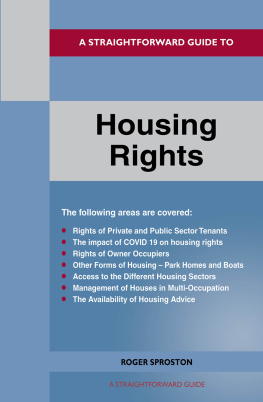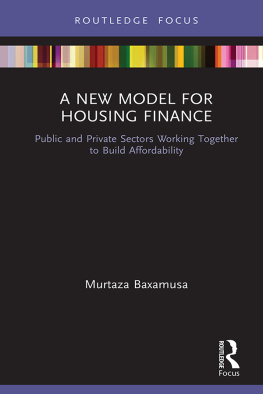General Guides to
Management In
Sheltered Housing
V.K. Leigh
Copyright 2011 by V.K. Leigh.
ISBN: Softcover 978-1-4628-6654-0
Ebook 978-1-4628-6655-7
All rights reserved. No part of this book may be reproduced or transmitted in any form or by any means, electronic or mechanical, including photocopying, recording, or by any information storage and retrieval system, without permission in writing from the copyright owner.
This book was printed in the United States of America.
To order additional copies of this book, contact:
Xlibris Corporation
0-800-644-6988
www.xlibrispublishing.co.uk
Orders@xlibrispublishing.co.uk
302092
Contents
Acknowledgement
I would like to thank my colleagues that gave me an insight to challenges that brought about the awareness and understanding of the issues which has greatly enriched this publication.
I would like to thank my wife and children for their scrutiny, contributions and patience in times of challenges.
I would also like to thank my very good friends, who inspired and supported me from the beginning to the completion of this publication.
Introduction
If you are looking for a retirement property now or are planning for the future, looking for information for yourself, or for a friend or relative, you can be guaranteed of a professional service at all times.
The pressure of sheltered housing, residential care homes and extra care housing are increasing in many areas of the country; since the population is producing older people and their life expectancy gets longer.
The NHS and Community Care Act of 1990 are favoured by the Government Legislation in areas such as home care packages over nursing, sheltered homes and extra care homes.
These are not classed as care homes because they are controlled by Scheme Managers.
This book is written with the intent to familiarise persons involved with the day to day services of older people.
It is also to lighten the awareness of Housing Associations, Health visitors, Social Services, Housing Organisations, National Health Services (NHS), Housing related staff, Persons with Interest of being a sheltered scheme manager.
This book also stands as a training guide, hand book to scheme managers; a resource material to all housing related organisational personnel and for quick referencing.
Mission Statement
All organisations, be it government or private sectors have their aims.
The aim of every organisation is about giving the best services and the best values that can be offered to their customers.
Some organisations improve their services and will do everything within their knowhow with greater or less positive results.
It is a good thing and also advisable to make comparisons of the various services being advertised before going for the long term best service.
Look into the offers that is being given
A MISSION STATEMENT could read as follows
 WE AIM TO PROVIDE A HIGH QUALITY, COST EFFECTIVE SUPPORT & FLEXIBLE SERVICES FOR THE RETIRED PEOPLE IN THEIR OWN HOMES.
WE AIM TO PROVIDE A HIGH QUALITY, COST EFFECTIVE SUPPORT & FLEXIBLE SERVICES FOR THE RETIRED PEOPLE IN THEIR OWN HOMES.
 WE AIM TO PROVIDE A COMFORTABLE, SAFE AND SECURED, MAINTAINED SHELTERED HOUSING SERVICES
WE AIM TO PROVIDE A COMFORTABLE, SAFE AND SECURED, MAINTAINED SHELTERED HOUSING SERVICES
 WE ARE COMMITTED TO RESPONDING TO CHANGING NEEDS, WORKING TOGETHER WITH EXTERNAL AGENCIES AND MONITORING THE NEEDS OF OUR TENANTS.
WE ARE COMMITTED TO RESPONDING TO CHANGING NEEDS, WORKING TOGETHER WITH EXTERNAL AGENCIES AND MONITORING THE NEEDS OF OUR TENANTS.
All organisations would like to offer the best whether it is government or private.
Each one has its aim in the form of Mission Statement.
The Oxford Dictionary defines Mission as Tasks or operations; task that one conceives oneself appointed to carry out
Statement is defined as Presentation in considered words or implied correctness of a fact or position or problem.
Mission Statement can be looked at asa written promise of facts, from an organisation about its operational views of the kind of tasks to its customers / clients.
It could be defined as an aim or intension being announced to unknown persons in order to convince them that the organisation concern, can offer the best in services to their flavour or otherwise in the areas being talked about.
Sheltered housing should not be mistaken for old people home. It is neither a refuge seeking place for an asylum.
Support, Help, Security(SHS).
SUPPORT IN TIMES OF NEED
HELP IN EMERGENCIES
SECURITY ON SITE
Support in times of need Support is one of the many key aims of establishing sheltered and extra care housing. No matter what the circumstances may be, there will always be support being rendered to older people, some with disabilities or ailment that is manageable by the individual.
Help in emergencies More so applies to extra care environment where carers are available 24 / 7. In emergencies, supports will still be rendered for the well being of the tenant.
Security on site Sheltered accommodations are easy targets to prey at; because of the vulnerability of the tenants. The tenants are made aware of the various circumstances of the type of dangers that are likely to occur.
This is one of the many discussions during every tenants meeting; such that they can protect themselves and their valuables.
As a duty, the sheltered scheme manager on site oversees everything including the building and the safety of the people.
The main front door entrance into the building is electronically secured to prevent intruders. Visitors and contractors can only be given access by methods of the intercom.
Types of Accommodations.
In the name of supported housing, there are various types of sheltered accommodations, namely:
Family
Drugs and Alcohol.
Young LadiesAge 16 to 25yrs old.
Older PeopleAge 60 yrs plus and more.
In this series, we will focus on the Older People living in sheltered accommodation and in the next series; we will be looking at Extra Care in more details.
These two services are very much on the same wavelength except that there are more involvement where Extra care is related.
These should not be mistaken for a care home.
Not all sheltered housing schemes for the elderly have staff working or living on site 24 /7.
In most sheltered schemes, the Scheme Managers work from 9.00am to 5.00pm, Mondays to Thursdays and on Fridays, 9.00am to 4.00pm.
The scheme managers are none residents due to modernisation and other reasons best known by the organisation and on each day of the week, before leaving the schemes, attending meetings, going for a break, the scheme manager must switch all communication devices except the telephone, over to the Community Alarms / Telecare or whatever the name they are called in that area, for the continuation of monitoring the tenants.
Telecare will continue to monitor and render assistance to the tenants for as long as the scheme manager is away; a handover is made as soon as the scheme manager or relief staff arrives in the schemes office.
In some organisations, the managers still live on sites.
What is Sheltered Housing?
WHAT DO WE UNDERSTAND BY THE WORD SHELTERED HOUSING?
Some of us think that it is a place to take refuge while others think that it is a kind of place of shelter to hide from the community for protection.
None of these relate to what sheltered housing is about.
Sheltered housing is intended specifically for older people, over 60 years old.
The housing is usually in schemes of 30 to 40, sometimes more in number, in self contained flats or bungalows.
Sheltered Housing is a place that is comfortable, easy to manage than the former home.
Next page












 WE AIM TO PROVIDE A HIGH QUALITY, COST EFFECTIVE SUPPORT & FLEXIBLE SERVICES FOR THE RETIRED PEOPLE IN THEIR OWN HOMES.
WE AIM TO PROVIDE A HIGH QUALITY, COST EFFECTIVE SUPPORT & FLEXIBLE SERVICES FOR THE RETIRED PEOPLE IN THEIR OWN HOMES. WE AIM TO PROVIDE A COMFORTABLE, SAFE AND SECURED, MAINTAINED SHELTERED HOUSING SERVICES
WE AIM TO PROVIDE A COMFORTABLE, SAFE AND SECURED, MAINTAINED SHELTERED HOUSING SERVICES WE ARE COMMITTED TO RESPONDING TO CHANGING NEEDS, WORKING TOGETHER WITH EXTERNAL AGENCIES AND MONITORING THE NEEDS OF OUR TENANTS.
WE ARE COMMITTED TO RESPONDING TO CHANGING NEEDS, WORKING TOGETHER WITH EXTERNAL AGENCIES AND MONITORING THE NEEDS OF OUR TENANTS.